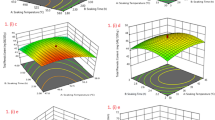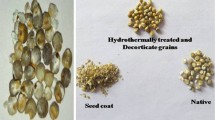Abstract
Black gram kernels with three initial moisture contents (10, 14 & 18 % w.b.) were steam treated in a continuous steaming unit at three inlet steam pressures (2, 3 & 4 kg/cm2) for three grain residence times (2, 4 & 6 min) in order to determine best treatment condition for maximizing the dhal yield while limiting the colour change in acceptable range. The dhal yield, dehulling loss and the colour difference (Delta E*) of the dehulled dhal were found to vary respectively, from 56.4 to 78.8 %, 30.8 to 8.6 % and 2.1 to 9.5 with increased severity of treatment. Optimization was done in order to obtain higher dhal yield while limiting the colour difference (Delta E*) within acceptable range i.e. 2.0 to 3.5 using response surface methodology. The best condition was obtained with the samples having 13.1 % initial moisture treated with 4 kg/cm2 for about 6 min to achieve a dhal yield of 71.2 % and dehulling loss of 15.5 %.






Similar content being viewed by others
Abbreviations
- Delta E*:
-
Total colour difference in CIELAB system
- Dt :
-
Relative change in the dehulling time, %
- Ld :
-
Dehulling loss, %
- Yd :
-
dhal yield, %
- 3D:
-
Three dimension
- ANOVA:
-
Analysis of variance
- C.V.:
-
Coefficient of variation
- GRT:
-
Grain residence time, min
- IMC:
-
Initial moisture content, % w.b.
- ISP:
-
Inlet steam pressure, kg/cm2
- RSM:
-
Response surface methodology
- BSS:
-
British standard screens
References
American Association of Cereal Chemists (AACC) (1995) Experimental (test) milling AACC Method 26–95 Test milling: temper table. In: American Association of Cereal Chemists Approved Methods, 1–9. American Association of Cereal Chemists Inc., St. Paul
ASAE Standards (2003) S352.2FEB03. Moisture measurement- unground grain and seeds. St. Joseph, Mich
Burridge P, Hensing A, Petterson D (2001) Australian pulse quality laboratory manual. SARDI Grain Laboratory for GRDC, Urrabrae
Daniella AL (2010) Effect of storage pre-treatments and conditions on the dehulling efficiency and cooking quality of red lentils. PhD thesis, Winnipeg, MB, Canada: University of Manitoba. Available from: http://hdl.handle.net/1993/3986. Accessed 31 Jul 2012
Deshpande SD, Balasubramanya RH, Khan S, Bhatt DK (2007) Influence of preliminary treatments on dal recovery and cooking characteristics of pigeon pea. J Agric Eng 44(1):53–56
Dorrel DG (1968) Seed coat damage in navy beans (Phaseolus vulgaris L.) induced by mechanical abuse. Ph.D Thesis. Michigan State University, East Lansing
Dutta SK, Nema VK, Bhardwaj RK (1988) Thermal properties of gram. J Agric Eng Res 39(4):269–275
Francis FJ, Clydesdale FH (1975) Food colorimetry theory and applications. Avi Publishing, Westport, pp. 131–224
Goyal RK, Vishwakarma RK, Wanjari OD (2007) Optimisation of the pigeon pea dehulling process. Biosyst Eng 99(1):51–56
Krapfenbauer G, Kinner M, Gossinger M, Schonlechner R, Berghofer E (2006) Effect of thermal treatment on the quality of cloudy apple juice. J Agric Food Chem 54:5453–5460
Kurien PP (1977) Grain milling technology. Paper presented at FAO experts meeting on grain legume processing. Central Food Technological Research Institute (CFTRI), Mysore
Kurien PP (1981) Advances in milling technology of pigeon pea. In: Proceedings of the international workshop on pigeon pea. International crops research institute for the semi-arid tropics, Patancheru, India: 321–328
Kurien PP (1987) Processing and utilization of grain legumes, human nutrition. Food Sci Nutr 41:203–212
Kurien PP, Parpia HAB (1968) Pulse milling in India I - processing and milling of Tur Arahar (Cajanas cajan Linn.). J Food Sci Technol (Mysore) 5:203
Phirke PS, Bhole NG, Adhaoo SH (1994) Effect of pretreatment on strength properties of pigeon pea grain for dehulling. Indian J Nutr Diet 31:265–272
Phirke PS, Bhole NG, Adhaoo SH (1996) Response surface modelling and optimization for dehulling of pigeon pea with different pretreatments and conditions. J Food Sci Technol 33:47–52
Shrivastava V, Mishra DP, Chand L, Gupta RK, Singh BPN (1988) Influence of soaking on various biochemical changes and dehusking efficiency in pigeon pea (Cajanus cajan L.) seeds. J Food Sci Technol 25(5):267–271
Singh U (1995) Method of dehulling of pulses: a critical appraisal. J Food Sci Technol 32(2):81–93
Sokhansanj S, Patil RT (2003) Dehulling and splitting pulses. Handbook of postharvest technology: cereals, fruits, vegetables, tea, and spices 93, 397
Tavman S, Tavman IH (1998) Measurement of effective thermal conductivity of wheat as a function of moisture content. Int Commun Heat Mass Transfer 25(5):733–741
Tiwari BK, Jaganmohan R, Vasan BS (2007) Effect of heat processing on milling of black gram and its end product quality. J Food Eng 78:356–360. doi:10.1016/j. jfoodeng.2005.10.003
Tiwari BK, Jaganmohan R, Vasan BS (2008) Effect of different premilling treatments on dehulling of black gram (Phaseolus mungo L.). J Food Process Preserv 32:610–620
Tiwari BK, Jaganmohan R, Venkatachalapathy N, Tito Anand M, Surabi A, Alagusundaram K (2010) Optimisation of hydrothermal treatment for dehulling pigeon pea. Food Res Int 43:496–500
Tiwari BK, Gowen A, Mckenna B (eds) (2011) Pulse foods: processing, quality and nutraceutical applications. Academic Press
Acknowledgments
The grant from the Indian Institute of Crop Processing Technology for conducting the research work is duly acknowledged.
Author information
Authors and Affiliations
Corresponding author
Additional information
Research highlights
• Hydrothermal treatment (HTT) was studied w.r.t. edible oil method (EDM) for black gram dehulling
• The efficacy of pre-treatment was a function of initial moisture and hydrothermal dosage
• HTT optimized with RSM to maximize yield, minimize loss & colour change (DeltaE*) within 2–3.5
• Optimized HTPT: grain moisture - 13.1 % (w.b.), steaming at 4 kg/cm2 inlet pressure for 6 min
• Optimized case: dhal yield-71.2 %, loss-15.5 % compared to 71.0 % yield and 15.9 % loss for EDM
Rights and permissions
About this article
Cite this article
Jerish Joyner, J., Yadav, B.K. Optimization of continuous hydrothermal treatment for improving the dehulling of black gram (Vigna mungo L). J Food Sci Technol 52, 7817–7827 (2015). https://doi.org/10.1007/s13197-015-1919-8
Revised:
Accepted:
Published:
Issue Date:
DOI: https://doi.org/10.1007/s13197-015-1919-8




